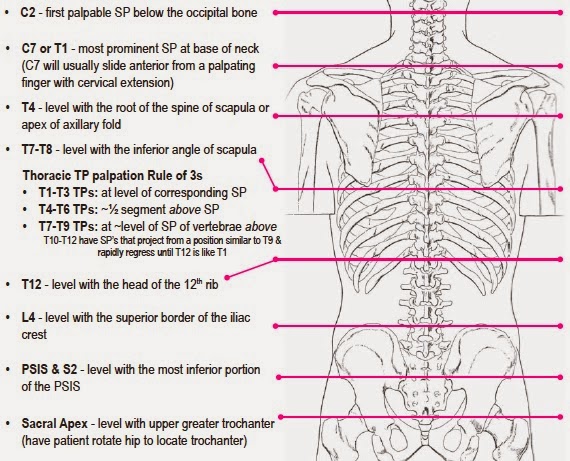Dr. F.L. Mitchell first described the "rule of threes" in 1979 to help clinicians landmark the transverse processes (TP's) of the thoracic vertebrae. The TP's are quite a deep structure and palpation can be difficult, so having a method to locate them is a valuable tool for any practitioner involved in physical medicine. Using the more easily palpable spinous processes (SP's) of the thoracic vertebrae, the rule of threes has been helping clinicians locate the TP's for many years but a pilot study from 2005 shows that the validity of that rule may not hold true.
The "rule of threes" states that to find the TP's of the thoracic vertebrae (T1-T12), one can follow this system:
1.) T1-T3 have the palpable tip of the SP's in the same plane as their TP's.2.) T4-T6 have SP's that project slightly downward and the tip is in a plane halfway between their own TP's and the TP's of the vertebrae below it.3.) T7-T9 have SP's that project more downward and line up in the same plane of the TP's of the vertebrae below it.4.) T10-T12 have characteristics of the three previous groups. T10 is similar to T9 with the SP in line with the TP's of the vertebrae below it; T11 SP is halfway between it's own TP's and the TP's of the vertebrae below (T12); T12 SP is in the plane of it's own TP's.
As nice as it would be if our bodies appeared exactly as they did in textbooks, that just isn't the case. Anatomical variations are well known in the body (the sciatic nerve is a great example) and it appears that the TP's of thoracic vertebrae are similar in that their arrangement differs in person to person. The paper by Dr. Geelhoed and Patricia Brewer shows that thoracic vertebra can differ greatly in where their TP's and SP's line up from T1-T12. They used 5 cadavers in their experiment, each displaying different alignment of SP's to the successive TP's. Some appeared where you may think they should, but others were far off. If you didn't click on the link above, click here to look at the paper. There may be a few limitations to the study (only using 5 cadavers, the age and physical condition of cadavers before death may affect results as well, and I'm guessing the dissections were done with the cadaver laying prone instead of upright) but it is still interesting to see these results and remember how different each patient is.
And remember to swing by the updated Professional Health Systems website. Lots of great learning tools, resources and other materials for everyone.
 |
| Landmarks of the spine including the Rule of Threes in the thoracic spine |
And remember to swing by the updated Professional Health Systems website. Lots of great learning tools, resources and other materials for everyone.
